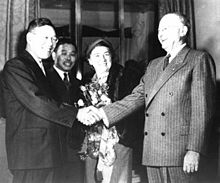Dodge Line
This article needs additional citations for verification. (February 2015) |

The Dodge Line or Dodge Plan was a financial and monetary contraction policy drafted by American economist Joseph Dodge for Japan to gain economic independence and stamp out inflation after World War II.[1] It was announced on March 7, 1949.
It recommended:
- Balancing the national budget to reduce inflation
- More efficient tax collection
- Dissolving the Reconstruction Finance Bank because of its uneconomical loans
- Decreasing the scope of government intervention
- Fixing the exchange rate to 360 yen to one US dollar to keep Japanese export prices low
Dodge had the Reconstruction finance bank, which was a major conductor of inflation-financed subsidies, shut down. He took important steps to restore Japan's foreign trade to private hands. The terms of all transactions were determined at the unchanging official exchange rate of $1 = 360 yen.
| Year | GNP Growth Rate (%) | Inflation Rate (%) | Monetary Base Growth Rate (%) | Gov's Debt Growth Rate (%) | Trade balance to GNP Ratio (%) | Major Events |
|---|---|---|---|---|---|---|
| 1945 | — | 51.1 | 148.2 | 9.0 | — | Surrender of Japan (Aug.) |
| 1946 | — | 364.5 | 67.6 | 418.3 | — | Financial asset freeze (Feb.); zaibatsu dissolution |
| 1947 | 8.4 | 195.9 | 132.9 | 75.9 | -6.2 | General strikes banned (Feb.); break up of monopolies, land reform, labor reform |
| 1948 | 13.0 | 165.5 | 61.5 | 135.1 | -3.8 | |
| 1949 | 2.2 | 63.3 | 0.3 | 56.0 | -2.0 | Dodge Plan (Feb.); Unification of multiple exchange rates to 360 yen per dollar (April); National Railway president Deat (July) |
| 1950 | 11.0 | 18.2 | 18.9 | 1.2 | 0.3 | Korean war started (June) |
| 1951 | 13.0 | 38.8 | 19.9 | 24.0 | -1.9 | Korea War armistice talk started |
| 1952 | 11.0 | 2.0 | 13.8 | 16.8 | -2.3 | |
| 1953 | 5.7 | 5.0 | 10.8 | 16.6 | -4.5 | Korean War armistice signed (July) |
| 1954 | 6.1 | 6.5 | -0.9 | 2.3 | -2.2 |
Influence and review[]
The Dodge Plan successfully controlled inflation, restored the market economy of Japan, and reopened it to international trade. It can be regarded as a classic example of breaking an inflation spiral. However, Dodge's plan’s operation also led Japan to a recession (ja:安定恐慌), which subsequently made the increase in production stall, and the fear of job losses increase. The severe recession continued not until the special export demand created and induced by the Korean War.[3]
References[]
- ^ Savage, J.D. (2002-06-01). "The Origins of Budgetary Preferences: The Dodge Line and the Balanced Budget Norm in Japan" (PDF). Administration & Society. doi:10.1177/009539902400387191. S2CID 154384324.
- ^ Toyo Keizai. 1979.
- ^ Ito, Takatoshi; Hoshi, Takeo (2019). The Japanese economy Second Edition. The MIT Press. p. 93. ISBN 9780262538244.
See also[]
- Occupied Japan
- Economy of Japan
- Japanese history stubs
- World War II stubs